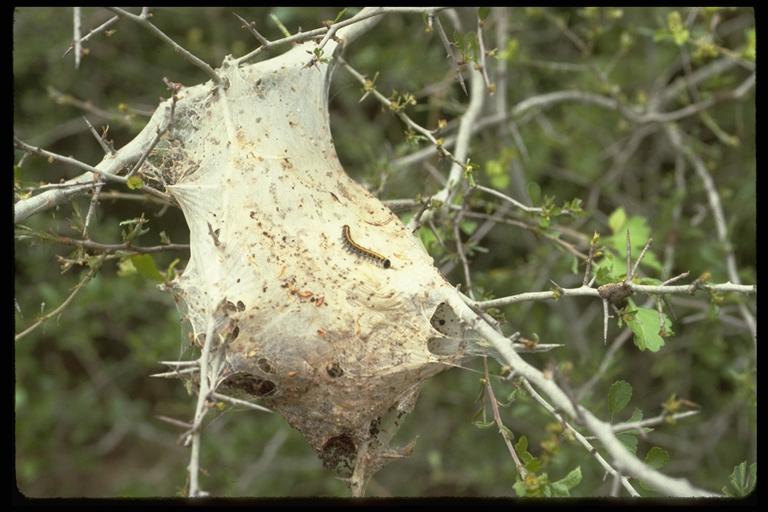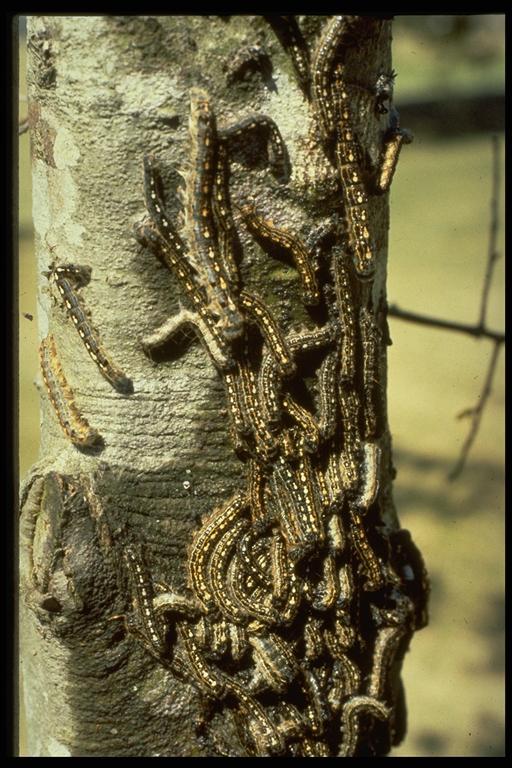
Eastern tent caterpillar, Malacosoma americanum (Fabricius) (Lepidoptera: Lasciocampidae), tent. Photo by Drees.
Common Name: Eastern tent caterpillar
Scientific Name: Malacosoma americanum (Fabricius)
Order: Lepidoptera
Description: Adult tent caterpillar moths have a 1-inch wingspread and are brown and yellowish with two diagonal markings on the forewings. Caterpillars (larvae) grow to over 1-½ inches long. They are brightly colored with long hairs on their bodies, mostly along the sides and marked with a solid white line down the center of the back. Other colors may vary but solid or broken lines of blue, yellow and black are also present. Larvae form a dense silken web usually in the crotch of small limbs which is used as a refuge at night and during rainy spells. The tent is expanded as the caterpillars grow.
The forest tent caterpillar, M. disstria Hübner , has a series of keyhole shaped white marks on the back. It does not form a tent and is found on a variety of hosts but prefers oaks in Texas. The western tent caterpillar, M. californicum (Packard), builds large tents and is found on a variety of trees and shrubs, including oaks and wild plums. Caterpillars have a series of white dashes on the back. The Sonoran tent caterpillar, M. tigris (Dyar), is usually found on oaks and builds a small tent. Caterpillars have one black segment but lack white markings on the back. Tent caterpillars are sometimes confused with fall webworm, Hyphantria cunea (Drury) (Lepidoptera: Arctiidae) which are quite different in appearance and biology. Fall webworms form loose silken webs around foliage upon which they are feeding rather than dense webs in crotches of branches which they leave to feed.

Forest tent caterpillars , Malacosoma disstria Hübner (Lepidoptera: Lasciocampidae), on tree trunk.
Photo by G. McIlveen, Jr.
Life Cycle: The winter is spent as a hard mass of eggs that encircle a twig. Larvae hatch in early spring just as the plants leaf out (mid-February to mid-March). Caterpillars develop through several stages (instars) before leaving the host plant to pupate in a cocoon. There is only one generation per year of tent caterpillars so all activity is usually over by May or June.
Habitat and Food Source(s): Caterpillars have chewing mouthparts. Adults have siphoning mouths. Eastern tent caterpillars prefer cherry, plum, peach, apple, hawthorn and related plants. If the food plant is defoliated they may move to less preferred hosts. Caterpillars leave their tents to feed on leaves and can quickly defoliate sections of a tree. Caterpillars may migrate and wander before they form a cocoon which may bring them into contact with homeowners. Adult moths are attracted to lights and can be abundant but only live for a few days.
Pest Status, Damage: Caterpillars feed on leaves of plums, peaches, cherries and a few related plants; silken tents formed by these caterpillars are persistent, unsightly and must be physically removed in ornamental plantings; medically harmless.
For additional information, contact your local Texas A&M AgriLife Extension Service agent or search for other state Extension offices.
Literature: Jackman 1988; Metcalf et al. 1962.